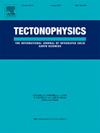Present-day incipient fault coalescence at a relay zone (Jiloca extensional basin, Spain): Evidence from instrumental seismicity
IF 2.7
3区 地球科学
Q2 GEOCHEMISTRY & GEOPHYSICS
引用次数: 0
Abstract
The relay zones between NW-SE to NNW-SSE striking faults of the Jiloca graben (Iberian Chain) mostly show distributed along-strike fault and fracture patterns. The latter are chiefly controlled by the Late Pliocene-Quaternary regional stress field, and secondarily respond to local controls from inherited structures. Such fracture patterns contrast with the classical models of transverse connecting faults controlled by relay kinematics. North of the Concud fault trace, at the relay zone with the Sierra Palomera fault, an unusually high seismic activity has been noticed since 2014, with magnitudes up to M = 3.5. Upgrading of the National Seismic Network allowed obtaining such new detailed records, while the installation of a new seismometer by the IGN within the study area has improved the reliability of focal depth data since 2017. A high-precision absolute relocation of seismicity from 01/01/2000 to 30/05/2022 has been carried out. The results show that (i) the epicentres are significantly clustered along a nearly N-S trending band, and (ii) the focal depths range from 0 to 14 km, in good agreement with the thickness of the brittle crust. This 3D spatial distribution of seismicity is interpreted as a consequence of activation of either a single fault or a fault zone, nearly vertical and N-S striking. Such structural setting is consistent with the surficial fracture patterns observed at both map and outcrop scale: NNW-SSE and NNE-SSW oriented faults and fractures, orthogonal to the ENE-WSW to ESE-WNW regional σ3 trajectories, together with NW-SE trending ones controlled by inherited contractive faults. The present-day seismic activity suggests that along-strike, incipient fault propagation at the relay zone between the Concud and Sierra Palomera faults is currently operating under the control of the remote stress field.
中继带(西班牙吉洛卡伸展盆地)现今萌生的断层凝聚:来自仪器地震的证据
吉洛卡地堑(伊比利亚地链)西北-东南至西北-东南走向断层之间的中继带大多呈现分布式沿走向断层和断裂形态。后者主要受晚渐新世-第四纪区域应力场的控制,其次是受继承结构的局部控制。这种断裂模式与由中继运动学控制的横向连接断层的经典模式形成鲜明对比。Concud 断层以北,在与 Sierra Palomera 断层的中继区,自 2014 年以来,地震活动异常频繁,震级最高达 M = 3.5。国家地震台网的升级使我们得以获得这些新的详细记录,而 IGN 在研究区域内安装的新地震仪则提高了自 2017 年以来焦点深度数据的可靠性。对 2000 年 1 月 1 日至 2022 年 5 月 30 日的地震活动进行了高精度的绝对重新定位。结果表明:(i) 震中明显集中在近南北走向的带状区域;(ii) 震源深度在 0 至 14 千米之间,与脆性地壳的厚度十分吻合。这种地震的三维空间分布被解释为一个近乎垂直和 N-S 走向的单一断层或断层带被激活的结果。这种结构设置与在地图和露头尺度上观察到的表层断裂模式一致:NNW-SSE 和 NNE-SSW 走向的断层和断裂与 ENE-WSW 至 ESE-WNW 的区域 σ3 轨迹正交,同时还有由继承性收缩断层控制的 NW-SE 走向的断层和断裂。目前的地震活动表明,Concud 断层和 Sierra Palomera 断层之间中继带的沿走向、初生断层扩展目前正在远程应力场的控制下运行。
本文章由计算机程序翻译,如有差异,请以英文原文为准。
求助全文
约1分钟内获得全文
求助全文
来源期刊

Tectonophysics
地学-地球化学与地球物理
CiteScore
4.90
自引率
6.90%
发文量
300
审稿时长
6 months
期刊介绍:
The prime focus of Tectonophysics will be high-impact original research and reviews in the fields of kinematics, structure, composition, and dynamics of the solid arth at all scales. Tectonophysics particularly encourages submission of papers based on the integration of a multitude of geophysical, geological, geochemical, geodynamic, and geotectonic methods
 求助内容:
求助内容: 应助结果提醒方式:
应助结果提醒方式:


